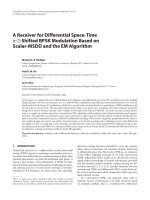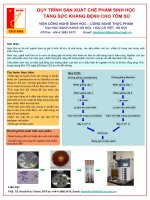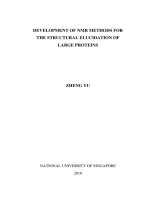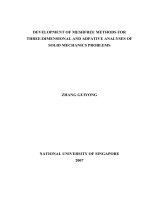Development of identification tools for distinguishing different coriander (Coriandrum sativum L.) genotypes based on its stem and branches characteristics
Bạn đang xem bản rút gọn của tài liệu. Xem và tải ngay bản đầy đủ của tài liệu tại đây (157.54 KB, 6 trang )
Int.J.Curr.Microbiol.App.Sci (2019) 8(4): 594-599
International Journal of Current Microbiology and Applied Sciences
ISSN: 2319-7706 Volume 8 Number 04 (2019)
Journal homepage:
Original Research Article
/>
Development of Identification Tools for Distinguishing Different
Coriander (Coriandrum sativum L.) Genotypes Based on
its Stem and Branches Characteristics
Amit*, T.P. Malik and S.K. Tehlan
Department of Vegetable Science, CCS, Haryana Agricultural University,
Hisar-125 004, India
*Corresponding author
ABSTRACT
Keywords
Coriander,
Genotype, Stem,
Characterization,
Identification
Article Info
Accepted:
07 March 2019
Available Online:
10 April 2019
An experiment was undertaken to categorise the coriander genotypes based on visual
morphological diagnosis. The investigation was carried out at research farm area of
department of vegetable science, Chaudhary Charan Singh Haryana Agricultural
University, Hisar during the year 2011-2012. Sixty genotypes of coriander obtained from
the Department of Vegetable Sciences were studied for the experiment, the seeds of all the
genotypes were sown in Augmented block design (ABD) in four blocks with 15 entries in
each block along with 4 checks (DH-5 = Hisar Anand, DH-36 = Hisar Sugandh, DH-228 =
Hisar Bhoomit and DH-246 = Hisar Surbhi) randomized with in block with single row of
3.0 m length at spacing of 50 X 20 cm within each row. Plant morphological parameters
i.e. stem pubescence, stem colour, streaks on stem and number of primary and secondary
branches per plant of all sixty genotypes was recorded for categorization. It was found
from the results that out of total sixty genotypes, maximum genotype’s stem were
pubescence, purple in colour and were more branched in terms of primary and secondary
branches. These parameters showed wide divergence and hence these can be used as
varietal identification.
thiamine, riboflavin, niacin, tryptophen,
vitamin B6, vitamin C and E (Holland et al.,
1991) iron, manganese, magnesium and
dietary fiber to the diet. It is highly reputed
ayurvedic medicinal plant commonly known
as “Dhanya” in India. This plant is highly
aromatic and has multiple uses in food and in
other industries. India is the biggest producer,
consumer and exporter of coriander in the
world with an annual production of around
three lakh tonnes. It is an annual, herbaceous
plant
which
originated
from
the
Introduction
Coriander is an annual spice herb that belongs
to the family of Apiaceae. It is used as a spice
in culinary, medicine (Kubo et al., 2004;
Delaquis et al., 2002) perfumery, food,
beverage, and pharmaceuticals industries. The
dried fruits are known as coriander or
coriandi seeds. In India they are called
dhania. The seeds are described as warm,
nutty, spicy, and orange-flavoured. The seed
contains significant quantities of carotene,
594
Int.J.Curr.Microbiol.App.Sci (2019) 8(4): 594-599
Mediterranean and Middle Eastern regions
and known as medicinal plants. It contains an
essential oil (0.03 to 2.6%) (Nadeem et al.,
2013) The green herb is employed for the
preparation of either steam-distilled essential
oil or the solvent extracted oleoresin (Nadia
and Kandi, 2012). Coriander has been
reported to posses many pharmacological
activities like antioxidant (Darughe et al.,
2012), anti-diabetic (Eidi et al., 2012), antimutagenic (Cortes et al., 2004), anti-lipidemic
(Sunil et al., 2012), anti-spasmodic (Alison et
al., 1999).
improvement. Germplasm characterization is
carried out in precision fields by spaced
planting under adequate agronomic conditions
and plant protection. For each accession
several morpho-agronomic traits are recorded
using the descriptors. Descriptors of
genotypes of crop species are required for
varietal identity, determining varietal purity,
establishing the distinctness of the new
genotypes from existing varieties and
documentation of genetic resources.
The continued development of new varieties
is cornerstone of increase in crop yield and
productivity in agriculture. Availability of
crop germplasm is a basic requirement for the
genetic improvement of crops. Genotype has
desirable traits in respect to yield, quality,
biotic and abiotic stress resistance. Scientists
must identify such genotypes having such
desirable traits. The systematic record
consists of genotype characters which can be
obtained by characterization. Although the
genotypes
are
available,
adequate
characterization
for
agronomic
and
morphological traits is necessary to facilitate
utilization by plant breeders. Characterization
is used to distinguish the genotypes on the
basis of their highly heritable characters that
help to select the most suitable genotypes
according to the needs of user/Plant Breeders.
The present study was undertaken for
categorization of coriander genotypes based
on its stable-morphological visual diagnostics.
The investigation was carried out at research
farm area of department of vegetable science,
Chaudhary
Charan
Singh
Haryana
Agricultural University, Hisar during the year
2011-2012. Sixty genotypes of coriander
obtained from the Department of Vegetable
Sciences were studied for the experiment, the
seeds of all the genotypes were sown in
Augmented block design (ABD) in four
blocks with 15 entries in each block along
with 4 checks (DH-5 = Hisar Anand, DH-36 =
Hisar Sugandh, DH-228 = Hisar Bhoomit and
DH-246 = Hisar Surbhi) randomized with in
block with single row of 3.0 m length at
spacing of 50 X 20 cm within each row. In the
study, plant morphological parameters were
identified which can be used to categorised
the coriander genotypes.
Materials and Methods
According to a recent IBPGR definition,
characterization consists of recording those
characters which are highly heritable, can be
easily seen by the eye and are expressed in all
environments.
Characterization
should
provide a standardized record of readily
assessable plant characters.
During the course of experiment, plant
morphological
parameters
i.e.
Stem
pubescence were recorded by noticed the
stem surface visually whether the surface is
smooth or pubescent; Stem colour was
observed visually whether the stem is green or
purple and on the basis of data recorded
genotypes were categorized in green colour or
purple colour of stem; Streaks on stem was
observed visually whether streak on the stem
This needs to be distinguished from
preliminary evaluation, which is the recording
of a limited number of agronomic traits
considered to be important in crop
595
Int.J.Curr.Microbiol.App.Sci (2019) 8(4): 594-599
was present or not; Number of primary
branches per plant (i.e. branch arises from the
main stem) was recorded and genotypes were
characterized into more branched (≥10), less
branched (<10) and the number of secondary
branches (i.e. branch arises from the primary
branches) was recorded by manually counting
the secondary branches and genotypes were
categorized into less branched (<20) and more
branched (≥20).
Results and Discussion
In the present research work it was noticed
that there was a great variation in the 60
genotypes on the basis of stem characteristics
i.e. stem pubescence, stem colour and streaks
on stem. Data of stem characteristics are
presented in Table 1 shows that in 45
genotypes stem pubescence were present and
15 genotypes were not having stem
pubescence.
Table.1 Categorization of coriander genotypes based on stem characteristics
Characteristics
Category
Stem
pubescence
Pubescence
Present
Stem colour
Streaks on the
stem
Number
of entry
45
Pubescence
Absent
15
Green
26
Purple
34
Present
30
Absent
30
Genotypes
DH-237-1, DH-239-1, DH-242, DH-242-1, DH-244, DH252, DH-254, DH-258, DH-260, DH-261, DH-268, DH275, DH-276, DH-276-1, DH-277, DH-278, DH-279,
DH-280, DH-280-1, DH-281, DH-281-1, DH-283-2, DH287, DH-288, DH-289, DH-290, DH-291, DH-292, DH293, DH-293-1, DH-293-2, DH-294, DH-294-1, DH-2942, DH-295, DH-296, DH-297, DH-297-1, DH-298, DH301, DH-302, DH-303, DH-303-1, DH-303-2, DH-304.
DH-238, DH-238-1, DH-239, DH-239-2, DH-239-3, DH240, DH-240-1, DH-244-1, DH-244-2, DH-282, DH-283,
DH-283-1, DH-284, DH-286, DH-297-2.
DH-239-1, DH-239-2, DH-239-3, DH-240-1, DH-242,
DH-242-1, DH-258, DH-260, DH-268, DH-275, DH-277,
DH-278, DH-280, DH-280-1, DH-281, DH-281-1, DH291, DH-293, DH-293-2, DH-294-1, DH-294-2, DH-295,
DH-297-1, DH-301, DH-303-1, DH-303-2.
DH-237-1-2, DH-238, DH-238-1, DH-239, DH-240, DH244, DH-244-1, DH-244-2, DH-252, DH-254, DH-261,
DH-276, DH-276-1, DH-279, DH-282, DH-283, DH-2831, DH-283-2, DH-284, DH-286, DH-287, DH-288, DH289, DH-290, DH-292, DH-293-1, DH-294, DH-296,
DH-297, DH-297-2, DH-298, DH-302, DH-303, DH-304.
DH-237-1-2, DH-239, DH-242, DH-242-1, DH-244, DH252, DH-261, DH-268, DH-276-1, DH-278, DH-279,
DH-280-1, DH-281-1, DH-282, DH-283, DH-284, DH286, DH-288, DH-292, DH-293, DH-293-1, DH-293-2,
DH-295, DH-296, DH-297, DH-297-1, DH-298, DH-301,
DH-302, DH-303-2.
DH-238, DH-238-1, DH-239-1, DH-239-2, DH-239-3,
DH-240, DH-240-1, DH-244-1, DH-244-2, DH-254, DH258, DH-260, DH-275, DH-276, DH-277, DH-280, DH281, DH-283-1, DH-283-2, DH-287, DH-289, DH-290,
DH-291, DH-294, DH-294-1, DH-294-2, DH-297-2, DH303, DH-303-1, DH-304.
596
Int.J.Curr.Microbiol.App.Sci (2019) 8(4): 594-599
Table.2 Categorization of coriander genotypes based on branches per plant
Characteristics
Category
Primary
branches
More
branched
(≥10)
Less
branched
(<10)
Secondary
branches
More
branched
(≥20)
Less
branched
(<20)
Number
Genotypes
of entry
35
DH-237-1-2, DH-238, DH-238-1, DH-239-1,
DH-239-2, DH-239-3, DH-240, DH-240-1,
DH-242, DH-244, DH-244-1, DH-258, DH260, DH-261, DH-268, DH-277, DH-279,
DH-280, DH-280-1, DH-281, DH-281-1, DH282, DH-283, DH-283-1, DH-283-2, DH-284,
DH-286, DH-287, DH-288, DH-289, DH-290,
DH-293-2, DH-294, DH-297, DH-303.
25
DH-239, DH-242-1, DH-244-2, DH-252, DH254, DH-275, DH-276, DH-276-1, DH-278,
DH-291, DH-292, DH-293, DH-293-1, DH294-1, DH-294-2, DH-295, DH-296, DH-2971, DH-297-2, DH-298, DH-301, DH-302, DH303-1, DH-303-2, DH-304.
41
DH-237-1-2, DH-238, DH-238-1, DH-239,
DH-239-1, DH-239-2, DH-239-3, DH-240,
DH-240-1, DH-242, DH-244, DH-244-1, DH244-2, DH-254, DH-258, DH-260, DH-261,
DH-268, DH-277, DH-278, DH-279, DH-280,
DH-280-1, DH-281-1, DH-283-1, DH-283-2,
DH-284, DH-286, DH-287, DH-288, DH-289,
DH-290, DH-291, DH-292, DH-293, DH-2931, DH-293-2, DH-294, DH-294-1, DH-297-1,
DH-303.
19
DH-242-1, DH-252, DH-275, DH-276, DH276-1, DH-281, DH-282, DH-283, DH-294-2,
DH-295, DH-296, DH-297, DH-297-2, DH298, DH-301, DH-302, DH-303-1, DH-303-2,
DH-304.
On the basis of visual observation of stem
color, 60 genotypes were categorized into two
groups. Twenty six genotypes showed green
stem and 34 genotypes showed purple
colouration of stem. Presented visualization
showed that among the 60 genotypes, 30
genotypes bear streaks on stem and 30
genotypes bears no streaks on the stem.
Similar study was also undertaken to develop
stem characteristics as identification tools in
thirty germplasm of fenugreek by Chauhan,
(2003).
The primary branches per plant ranged from
5.2 to 14.2 (Table 2). Accordingly sixty
genotypes were classified into two groups.
Thirty five genotypes were classified into
more branched (≥10) group and 25 genotypes
were classified as less branched (<10) group.
Highest primary branches were observed in
DH-291 and lowest were in DH-301.
Whereas, secondary branches per plant
ranged from 12.4-34.2. Accordingly sixty
genotypes were classified into two groups.
597
Int.J.Curr.Microbiol.App.Sci (2019) 8(4): 594-599
Forty one genotypes were classified as more
branched (≥20) and 19 genotypes were
classified into less branched (<20) group.
Highest secondary branches were present in
DH-261 and lowest was in DH-301. Filiz et
al., (2002) also studied 43 genotypes and
found that number of branches also helps in
characterizing the genotypes. Similar study
was also undertaken at Jobner, Rajasthan by
Rajput et al., (2003) to develop branches per
plant as identification tool in coriander.
Mazza, G., 2002. Antimicrobial
activity of individual and mixed
fractions of dill, cilantro, coriander
and
eucalyptus
essential
oils.
International Journal of Food
Microbiology. 74:101–109.
Eidi, M., Eidi, A., Saeidi, A., Molanaei, S.,
Sadeghipour, A., Bahar, M. and
Bahar, K., 2012. Effect of coriander
seed (Coriandrum sativum L) ethanol
extract on insulin release from
pancreatic beta cells in streptozotocininduced diabetic rats. J. Phytother.
Res. 23(3):404-406.
Filiz, A., Ahmet, M., Neset, A. and Bilal, G.,
2002. Seed yield, yield components
and essential oil of selected coriander
lines. Journal of herbs, spices and
medicinal plants. 9(2-3): 71-76.
Holland, B., Unwin, I.D. and Buss, D.H.,
1991. Seed yield and essential oil of
coriander lines. Vegetables, Herbs and
Spices. 4: 163.
Kubo I., Fujita K., Kubo A., Nihei, K. and
Ogura, T., 2004. Antibacterial activity
of coriander volatile compounds
against Salmonella choleraesuis.
Journal of Agriculture and Food
Chemistry. 52(11): 3329-3332.
Nadeem, M., Anjum, F.M., Khan, M.I.,
Tehseen, S., El-Ghorab, A. and Sultan,
J.I., 2013. Nutritional and medicinal
aspects of coriander (Coriandrum
sativum L.). A review. Brit. Food J.
115(5):743-755.
Nadia, G. and Hala, K., 2012. Influence of
cobalt
nutrition
on
coriander
(Cariandrum sativum L.) Herbs yield
quantity and quality. J Appl. Sci. Res.
8(10):5184-5189.
Rajput, S.S., Singh, D., and Parsa, A.,
2003.Variability in coriander for yield
and yield components. Journal of
Spices and Aromatic Crop., 12(2):
162-164.
Sunil, C., Agastian, P., Kumarappan, C. and
From the findings it is concluded that stem
characteristics and branches of coriander
showed wide divergence and hence these can
be consider and used as a tool for varietal
identification and selection for research
purpose by plant breeder and agricultural
scientist.
References
Alison, M.G. and Peter, R.F., 1999. Insulin
releasing and insulin like activity of
the traditional anti-diabetic plant
Coriander sativum (coriander). British
J. Nutr. 81(3): 203-209.
Chauhan, P., 2003.Characterization and
vigour
assessment
studies
in
fenugreek. Ph.D. Thesis. Department
of Seed Science and Technology, CCS
Haryana Agricultural University,
Hisar.
Cortes-Eslava, J., Gomez-Arroyo, S. and
Villalobos-Pietrini,
R.,
2004.
Antimutagenicity
of
coriander
(Coriandrum sativum) juice on the
mutagenesis produced by plant
metabolites of aromatic amines. J.
Toxicol. Lett. 153:283-292.
Darughe, F., Barzegar, M. and Sahari, M.A.,
2012. Antioxidant and antifungal
activity of Coriander (Coriandrum
sativum L.) essential oil in cake. Int.
Food Res. J. 19(3):1253-1260.
Delaquis, P.J., Stanich, K., Girard, B. and
598
Int.J.Curr.Microbiol.App.Sci (2019) 8(4): 594-599
Ignacimuthu, S., 2012. In vitro
antioxidant,
antidiabetic
and
antilipidemic activities of Symplocos
cochinchinensis (Lour.) S. Moore
bark. J. Food Chem. Toxicol.
50(5):1547-1553.
How to cite this article:
Amit, T.P. Malik and Tehlan, S.K. 2019. Development of Identification Tools for
Distinguishing Different Coriander (Coriandrum sativum L.) Genotypes Based on its Stem and
Branches Characteristics. Int.J.Curr.Microbiol.App.Sci. 8(04): 594-599.
doi: />
599









